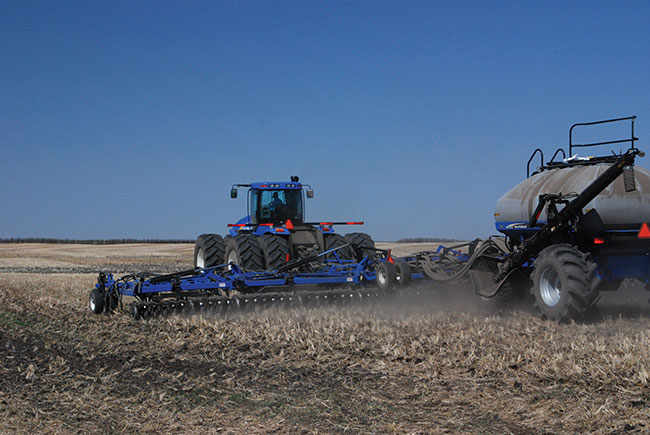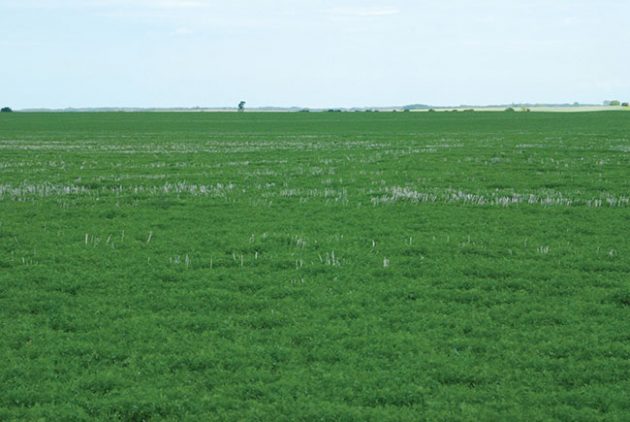
Features
Pulses
Assessing starter fertilizer for pulses
Does applying more help compensate for low fertile soils?
January 22, 2020 By Bruce Barker
 A 10 kg N/ha starter blend in the seedrow was sufficient for fababean, pea, lentil and chickpea.
Photo by Bruce Barker.
A 10 kg N/ha starter blend in the seedrow was sufficient for fababean, pea, lentil and chickpea.
Photo by Bruce Barker. On low fertility soils, growers often wonder if starter fertilizer would provide a benefit to pulse crops. Research at the University of Saskatchewan’s soil science department looked into crop safety and the response of pulse crops to starter nitrogen (N), phosphorus (P) and sulfur (S) fertilizers. Generally, there was little crop response to starter fertilizer.
“Safe seedrow rates for phosphorus and potash have been established for pulses, but tolerance and response to starter blends containing a higher analysis of N along with phosphorus and sulfur was not known,” says Jeff Schoenau, professor of soil fertility at the University of Saskatchewan. “We wanted to look at some of the common starter blends and products to see if there would be a crop response.”
Schoenau, along with colleague Tom King, supervised the research conducted by Harshini Galpottage Dona for her master of science thesis. Galpottage Dona conducted both greenhouse and field trials.
In the greenhouse trial, she collected soil from a loamy textured Brown Chernozem field in southern Saskatchewan. Soybean, green pea, fababean, black bean, small red lentil and desi chickpea were seeded into the soil with a simulated 15 per cent seedbed utilization (1.5-inch opener on 10-inch row spacing) and grown for 30 days under greenhouse conditions.
Four starter N rates of zero, 10, 20 and 30 kilograms of nitrogen per hectare (kg N/ha) were applied for seven different fertilizer blends/products: monoammonium phosphate (MAP; 11-52-0) alone, MAP plus urea (28-26-0), MAP plus AS (16-26-0-12), and four composite granular fertilizers including MES-15 (13-33-0-15), Koch 12-45-0-05, Simplot 16-20-0-13, and Anuvia Symtrx 16-20-0-12.
 The amount of nutrients applied varied by product/blend. For example, a 10 kg/ha N rate applied as MAP (11-52-0) would have resulted in 47.3 kg P2O5/ha also being applied with the seed. Conversely, the same 10 kg N rate in a blend of urea and MAP (28-26-0) would have resulted in only 9.3 kg P2O5/ha applied.
The amount of nutrients applied varied by product/blend. For example, a 10 kg/ha N rate applied as MAP (11-52-0) would have resulted in 47.3 kg P2O5/ha also being applied with the seed. Conversely, the same 10 kg N rate in a blend of urea and MAP (28-26-0) would have resulted in only 9.3 kg P2O5/ha applied.
Overall, the six legume crops showed the following relative sensitivities to crop injury from starter fertilizer placed in the seed row, from most sensitive to least: lentil > pea > chickpea > soybean > black bean > fababean. Lentil, pea and chickpea could generally only tolerate the 10 kg N/ha rates while soybean and black bean could tolerate 10 to 20 kg N/ha.
Fababean emergence appeared relatively unaffected by all three rates of N (10, 20 and 30 kg N/ha) and showed least sensitivity to seedrow fertilizer. In a separate trial, a zero tannin fababean variety had some sensitivity to the 20 and 30 kg N/ha rates of fertilizer application with reduced emergence compared to greater tolerance of higher rates of N in a tannin fababean variety.
“The greenhouse trials come with a caution that the soils were warm with good moisture. There wasn’t a lot of trash and they were low in available nitrogen,” Schoenau says. “Under field conditions, safe seedrow fertilizer rates might be lower.”
The ammonium phosphate sulfate fertilizer products also tended to produce less injury than the equivalent analysis blends when applied at a given N rate.
Soybean and black bean were most responsive to starter fertilizer with increased 30-day biomass production and nutrient uptake. Pea, fababean, lentil and chickpea early season biomass and nutrient uptake did not respond very much to the starter fertilizer applications, and there would be no benefit realized from going above 10 kg N/ha on this soil from any of the fertilizer products or blends.
“For most pulse crops, large amounts of nitrogen really are not necessary as long as inoculation produces good nodulation and nitrogen fixation. The exception may be dry bean because we really don’t have a good inoculant for that crop,” Schoenau says.
Galpottage Dona also conducted several field trials. In 2018 she compared four rates of a starter blend applied in the seedrow with lentil and soybean with 15 per cent seedbed utilization. A blend of urea (46-0-0) and MAP (11-52-0) with an analysis of 28-26-0 was applied at a rate that supplied 0, 10, 20 and 30 kg N and P2O5/ha.
Consistent with the controlled environment study, 10 kg of N and 10 kg of P2O5/ha as seed-row placed urea-MAP blend (28-26-0) was sufficient to maximize yield, N fixation and P uptake, but did not significantly reduce emergence, stand count or biological nitrogen fixation.
Another field-scale soybean experiment was conducted near the site where soil was collected for the controlled environment study. A 75:25 blend urea and monoammonium phosphate fertilizer (37-13-0) was applied that produced rates of zero, 17, 34 and 51 kg N/ha and zero, 6, 12 and 18 kg P2O5/ha. A paired row sideband configuration separated the fertilizer from the seed, and was used to limit the potential injury to soybean from the higher rates of N fertilizer.

Study results show a starter rate of 10 kg N/ha placed in the seedrow should maximize early-season growth in lentil. Bruce
In this study, poor nodulation was observed throughout the growing season due to drought conditions, which would have limited N fixation. As a result, the highest rate of N (54 kg N/ha) produced the highest soybean yield even though the plant stand was reduced at the high N rate.
Schoenau says that based on the results of Galpottage Dona’s trials, 10 kg N/ha rate of a starter blend placed in the seedrow should be sufficient to maximize fababean, pea, lentil and chickpea early season growth. Higher rates of 20 to 30 kg N/ha in a starter blend may be desirable for black bean and soybean, especially under very low fertility and good moisture conditions.
“Maybe under some conditions with very low soil fertility, there might be a benefit to go with higher rate, but placement separate from the seed row would be the best option for higher rates,” Schoenau says.